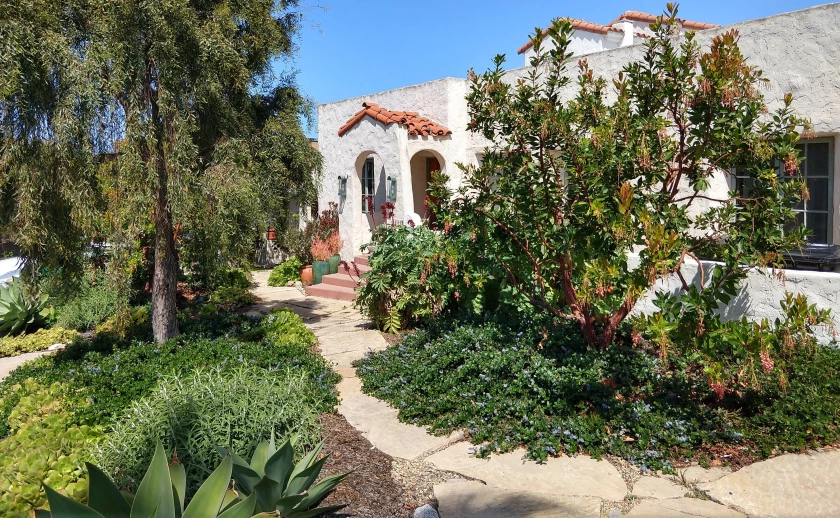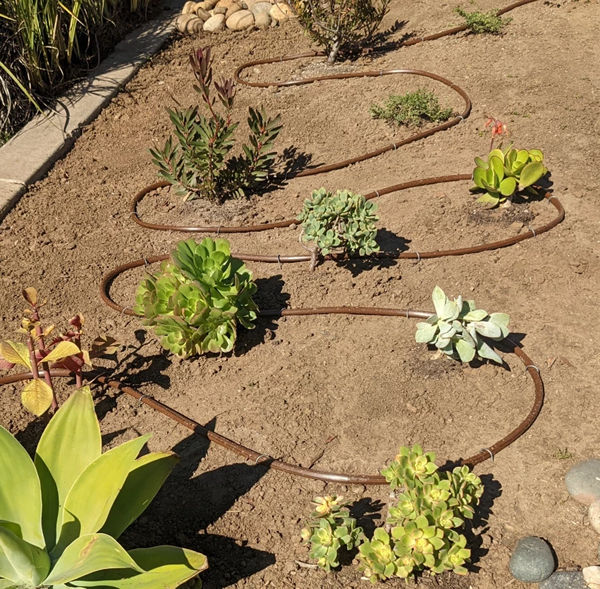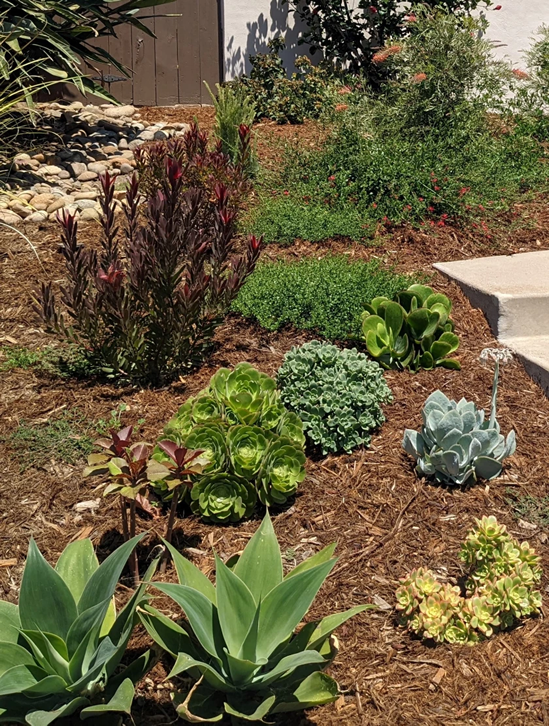Climate change to factor into gardens of our future

A front-lawn makeover with climate-appropriate plants and trees help shade the soil and house, provide privacy from the street, and offer color to view from the interior rooms. Plants shown are arbutus marina, Ceanothus ‘Yankee Point’, Melianthus major, Salvia leucantha ‘Midnight’, Acacia salicina.(Lynlee Austell)
Pay attention now to what works well with low water, low effort
BY LYNLEE AUSTELL
(This article originally appeared in the June 9, 2022 edition of the San Diego Union-Tribune)
It is customary for us to think of drought and climate change as being the same. They are not. Climate change requires us to change our usual practices and plant palette. Drought causes us to temporarily adapt. As a sustainable landscape expert, I first identify what is working: plants and trees that cover the soil, provide shade, nectar and habitat for beneficials, etc., without requiring too many resources.
Take some time to observe your garden and surrounding landscapes. Think kindly toward the plants you thought were boring or tired, because they don’t really require much care nor need regular irrigation. They are the vegetation that will carry us into the future.
Trees are the most important garden assets worth saving. They need deep and infrequent irrigation to establish a drought-tolerant root structure. For established trees and shrubs, convert overhead sprays to drip irrigation. Use this excellent tree-irrigation guide from The University of California to help your trees endure. There are many available trees rated for very low water use. One resource is the SelecTree online tool by the Urban Forest Ecosystems Institute at Cal Poly.
Fruit trees are different than ornamental trees in that we apply resources to produce yield. Already, climate-change conditions exist that are detrimental to stone fruits, citrus, nuts, etc., such as temperatures being too high to allow fruit set. Even if you only have one fruit tree, you will find this UC guide to home orchards helpful. This collection of articles and videos, some in Spanish, addresses how to help our landscapes deal with drought and the effects of climate change.

A front-lawn makeover with climate-appropriate plants and trees can shade the soil and house, provide privacy from the street, and offer color to view from the interior rooms. Plants shown are arbutus marina, Ceanothus ‘Yankee Point’, Melianthus major, Salvia leucantha ‘Midnight’, Acacia salicina.
(Lynlee Austell)
Flowering shrubs are the next most important foundation in your garden. Observing unirrigated neighborhoods after the 2008 financial crisis, we saw that rhaphiolepis, pittosporum, xylosma and many other foundation shrubs persisted without inputs of time, treasure and water. We are lucky in San Diego to be able to grow just about anything if we apply the required resources. Nevertheless, to be sustainable is to do less to it and get more out of it. Toyon, lemonadeberry, Lavatera maritima, Ceanothus and Salvia clevelandii all do beautifully without regular irrigation and do not require regular maintenance. Meanwhile, they provide important habitat and food for birds and beneficial insects with their flowers and berries, which are also pleasing to our senses.
Next are ground covers. No longer should we use tiny, flat ground covers requiring overhead irrigation. That is an unpalatable recipe for runoff and weeds. Ground covers are plants that grow 12 to 24 inches tall and 4 to 12 feet in diameter, especially on slopes. After all, you’re not going to play bocce on your back hillside nor have tea parties on your front bank. You’ll be stunned at the number and variety of beneficial insects you will attract with evergreen, flowering ground covers like Baccharis pilularis ‘Pigeon Point’, Ceanothus ‘Yankee Point’, Gambelia speciosa, Salvia x ‘Bee’s Bliss’ and Salvia leucophylla ‘Point Sal’. These plants may look puny when you take them home in a 1-gallon pot, but within 6 months, the Baccharis and Salvias will be 4 feet in diameter and eventually up to 6 to 12 feet wide.

The same slope, after mulch is added, shows four months’ grow-in.(Lynlee Austell)
To establish plantings, be sure to drip irrigate the root ball margin and out from there, not at the base of the main stem. The most common cause of new installation failure is when one emitter is set right at the base of the main stem and nowhere else. Picture the plant behaving like it is limited to the pot, with wet feet, kind of like when you keep your feet in wet, warm shoes. There is a fungus among us! Roots do not take excursions into dry soil, “seeking” water. Roots grow where the water is. In-line drip and pressure-compensating button drippers are the most reliable methods. Any other type of adjustable or noncalibrated emitter cannot deliver water reliably and often fails before the establishment period is over.
We irrigate climate-appropriate plants to simply establish the plants so that they resist drought with deep, extensive root systems. In-line drip can be the best choice for home landscapes. However, it is possible, and some would say preferable, to establish native landscapes with overhead irrigation via streaming nozzles and adequate mulch. Do your homework before going to the nursery and falling in love with fabulous, floriferous little plants that can’t give you much in return for your efforts and capital.
Observation helps us see indicators of climate change and drought, and it can also show us what is working best in our habitat. Take a closer look at the trees, shrubs and ground covers thriving in our countryside, along our roads and in our neighborhoods. Study that beautiful flowering ground cover spreading widely over a slope. We can easily see where resources are used judiciously and where we get more out of our landscapes while putting less into them.
Austell has been a UCCE Master Gardener and Sustainable Landscape Expert since 2008. She gives lectures and helps beautify landscapes in San Diego County.

